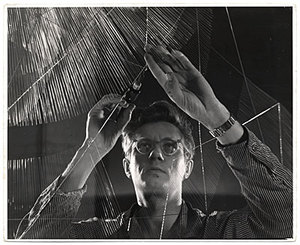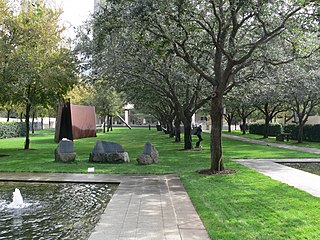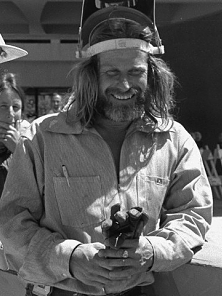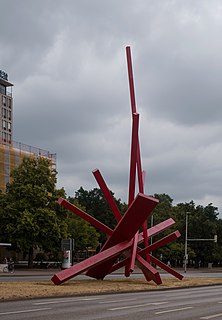
The Milwaukee Art Museum (MAM) is an art museum in Milwaukee, Wisconsin. Its collection contains nearly 25,000 works of art.

Richard Lippold was an American sculptor, known for his geometric constructions using wire as a medium.

Opened in 2003, the Nasher Sculpture Center is a museum in Dallas, Texas, that houses the Patsy and Raymond Nasher collection of modern and contemporary sculpture. It is located on a 2.4-acre (9,700 m2) site adjacent to the Dallas Museum of Art in the Dallas Arts District.

Marco Polo "Mark" di Suvero is an abstract expressionist sculptor and 2010 National Medal of Arts recipient.
Rachel Harrison is an American visual artist known for her sculpture, photography, and drawing. Her work often combines handmade forms with found objects or photographs, bringing art history, politics, and pop culture into dialogue with one another. She has been included in numerous exhibitions in Europe and the US, including the Venice Biennale, the Whitney Biennial and the Tate Triennial (2009). Her work is in the collections of major museums such as The Museum of Modern Art, New York; Metropolitan Museum of Art, New York; Hirshhorn Museum and Sculpture Garden, Washington, D.C.; and Tate Modern, London; among others. She lives and works in New York.

Joel Shapiro is an American sculptor renowned for his dynamic work composed of simple rectangular shapes. The artist is classified as a Minimalist as demonstrated in his works, which were mostly defined through the materials used, without allusions to subjects outside of the works. He lives and works in New York City. He is married to the artist Ellen Phelan.

John Raymond Henry is an internationally renowned sculptor. Since 1971, Henry has produced many monumental and large-scaled works of art for museums, cities and public institutions across the United States, Europe, and Asia. He has created some of the largest contemporary metal sculpture in the United States, and his sculpture is designed, engineered, fabricated, and erected by his own studio in Chattanooga, Tennessee.

Museum Tower is a 42-story, 170 m (560 ft) skyscraper in the arts district of Dallas, Texas. Completed in January 2013, the building is the tallest new structure to be built in the city in recent years, and is now the second-tallest all-residential building in Dallas, behind Gables Republic Tower.
Charles Albert Ginnever, was an American sculptor known primarily for large-scale abstract steel sculptures that defy simple understanding, as the works seem to constantly change form as one moves around them in time and space.

Snowplow is an abstract outdoor sculpture by American artist Mark di Suvero located on the grounds of the Indianapolis Museum of Art. The sculpture was purchased in 1975 by the Indianapolis Sesquicentennial Commission and first installed in Indianapolis, Indiana in 1977.

Wind Leaves is a public artwork by American artist Ned Kahn located on the downtown lakefront Pier Wisconsin in Milwaukee, Wisconsin, United States. It was created in 2006 and consists of a series of seven 30 ft (9 m) tall structures made from aluminum and stainless steel. The structures, which move with the wind, have leaf forms at the top covered by thousands of stainless steel disks.

Bay View Series is a public artwork by American artist Peter Flanary (artist) located on the Bay View Public Library grounds, which is on the south side of Milwaukee, Wisconsin, United States. Flanary's 1993 Bay View Series consists of three granite rocks and one chunk of taconite iron ore. All have text on them, and the iron ore piece has a hole in the middle. The largest piece measures approximately 68 x 77 x 28 in.

Are Years What? is a sculpture by American artist Mark di Suvero. It is in the collection of the Hirshhorn Museum and Sculpture Garden, in Washington, D.C., United States. The sculpture is named after poet Marianne Moore's "What Are Years". From May 22, 2013 through May 26, 2014, the sculpture resided temporarily in San Francisco, as part of the San Francisco Museum of Modern Art's Mark di Suvero exhibition at Crissy Field.
Sinai is a public artwork by the Japanese American artist Isamu Noguchi, located at the Lynden Sculpture Garden, which is near Milwaukee, Wisconsin, United States. Sinai is a cast-iron sculpture measuring 36 inches (910 mm) high, 21 inches (530 mm) wide, and 11 inches (280 mm) deep. It is part of a series of work created between the 1967 and 1969, during which time Noguchi was collaborating with the Japanese stone carver Masatoshi Izumi.

World War I Memorial Flagpole (Eagle) is a public artwork by American artist Benjamin Franklin Hawkins located on the lakefront in Milwaukee, Wisconsin, United States. The artwork was made in 1932 from bronze and granite. It measures approximately 80 inches in height, and it sits at the Northeast corner of North Prospect Avenue and Lincoln Memorial Drive.

Steel Reborn is a public art work by American artist Charles Toman, located in front of the Miller Compressing Company on the south side of Milwaukee, Wisconsin. The abstract artwork is a three-ton welded steel ball placed atop a 35-foot base. It is located at 1640 W Bruce St.

Iroquois is a sculpture by American artist Mark di Suvero, owned by the Association for Public Art. The artwork is located at the Benjamin Franklin Parkway, at Eakins Oval and 24th Street, Philadelphia, United States. Iroquois is one of the many sculptures included in the Association's for Public Art's Museum Without Walls: AUDIO™ interpretive audio program for Philadelphia's outdoor sculpture.
Lynden Sculpture Garden is a 40-acre outdoor sculpture park located at 2145 West Brown Deer Road in Milwaukee, Wisconsin in Milwaukee County. Formerly the estate of Harry Lynde Bradley and Margaret Blakney Bradley, Lynden is home to the collection of more than 50 monumental sculptures collected by Margaret Bradley between 1962 and 1978. The collection features works by Alexander Archipenko, Henry Moore, Barbara Hepworth, Clement Meadmore, Marta Pan, Tony Smith, Mark di Suvero and others sited across 40 acres of park, lake and woodland.

The Lovers is a public art work by artist Mark di Suvero located at the Lynden Sculpture Garden near Milwaukee, Wisconsin. The sculpture is an abstract form; it is installed on the lawn.

Bunyon's Chess is an outdoor 1965 sculpture by Mark di Suvero, installed at Olympic Sculpture Park in Seattle, Washington. The stainless steel and wood piece is 22 feet (6.7 m) tall.
















